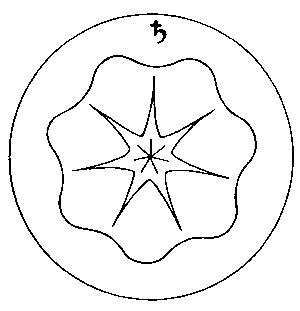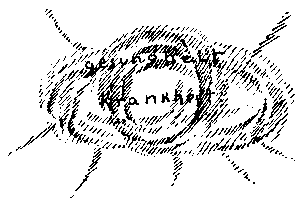Saturn

Saturn (ancient Egyptian: Hor-ka-pet; Hebrew: שַׁבְּתַאי Shabatai; Sanskrit: शनि Shani; astronomical sign: ♄) is in the occult sense the outermost planet of our solar system and closes it off, as it were, against the outer cosmos as an independent being. Saturn's sidereal orbital period is 29.457 years. According to Rudolf Steiner, the planets known today beyond Saturn, in particular Uranus and Neptune, came into being later and are not directly connected with the straight-line development of our planetary system.
„It is the quality of Saturn, above all, to cool and seldom to dry, probably because it is farthest from the heat of the sun and the moist exhalations of the earth. In the case of both Saturn and the other planets, there are also forces arising from the observation of their aspects to the Sun and Moon, for some of them seem to modify - by increase or decrease - conditions in the environment in one way, some in another.“
Every 20 years or so, a Great Conjunction of Saturn and Jupiter takes place. Some astronomers and historians suggest that the Star of Bethlehem at the time of Jesus' birth may have been a Great Conjunction in the years 7 to 6 B.C.[1][2] The most recent, spiritually very significant Great Conjunction occurred in the evening of December 21, 2020, in the zodiac sign of Capricorn.
The physical planet
Saturn is the sixth planet in the solar system as seen from the Sun and, with an equatorial diameter of about 120,500 kilometres (9.5 times Earth's diameter), is the second largest after Jupiter. However, with 95 Earth masses, it has only 30 % of Jupiter's mass. Because of its conspicuous ring system, visible even in a small telescope, it is often called the ring planet, although ring systems have also been found on the other three gas planets.
Saturn has an average distance from the Sun of a good 1.43 billion kilometres, its orbit runs between that of Jupiter and that of Uranus, which is further away from the Sun. It is the outermost planet that is also clearly visible to the naked eye and was therefore known thousands of years before the invention of the telescope.
As a gas planet, Saturn has no solid surface. Its upper layers consist of about 96% hydrogen. Of all the planets in the solar system, Saturn has the lowest mean density (about 0.69 g/cm³).[3] Saturn stands out from the other planets because of its distinctive, bright and long-known rings, which consist largely of chunks of water ice and rock.
The apparent angular diameter of the planetary body is between 15″ and 20″, depending on the distance from Earth, and that of the rings between 37″ and 46″. The so-called equatorial stripes of the cloud layers are less distinct on Saturn than on Jupiter, which is probably related to a high-layered haze.
As of 2019, 82 of Saturn's moons have been discovered, more than Jupiter's. Saturn's largest moon by far is Titan, 5150 kilometres across.
The planet is named after the Roman god of wealth and harvest, Saturn. Its astronomical symbol ♄ stylises the god's crescent.
Spiritual significance of Saturn

The Saturn sphere is the dominion of the Thrones, who were the lords of the Old Saturn evolution. The leading Archangel of the Saturn sphere is Oriphiel. In Hinduism, the regent of Saturn is called Shani (Sanskrit: शनि Śani m.). He is the son of the Sun God Surya and his wife Chhaya ("Shadow"). His weapons are the spear and the arrow bow. His vahana, his animal vehicle, is a crow. The astrological influence of Shani is considered a bad omen.
Today's Saturn came into existence when, during the earth evolution, Old Saturn, the first embodiment of our planetary system, repeated itself in an abbreviated form. At that time, Saturn resembled a comet wandering around Saturn's orbit with its tail pointing outwards. Due to the gravitational forces of the planetary system, it later formed a closed ring around Saturn. Like Old Saturn, today's Saturn consists essentially only of heat substance and, according to the laws of Goethe's theory of colour, appears bluish because it is seen as a dark, lightless body through sunlit space. The stratification of Saturn's rings is connected with the different heat layers of which each Saturn consists; one has to distinguish here between neutral, psychic and physically perceptible heat.
„The Saturn of today relates to the Earth as a boy to an old man. The same living conditions that Saturn is going through today, our Earth went through in the past. Therefore, in real occultism one does not speak of Saturn, of the Sun, and so on, but of a Saturn, a Sun, and so on. Our Earth is an older Saturn.“ (Lit.:GA 284, p. 58)
In the human organism the Saturn forces act above all on the spleen, in the plant kingdom they are essentially involved in seed formation, and among the earthly metals they have brought forth lead. As a tree, the beech is associated with Saturn. In language it reveals itself through the vowel U.
The rings of Saturn
According to Rudolf Steiner, Saturn's ring system is the cosmic expression of those health-making, healing forces that also operate in our rhythmic system, i.e. in breathing and circulation.
„We pass from nourishment into healing, in that the human being from below always actually has the tendency to become ill, and in his middle organism, in the circulatory organism, must continually develop the tendency to remain healthy. As the impulses of recovery thus continually arise in our middle organism, they leave something straight after the head-nerve-sense system; and we then come, thirdly, to the nerve-sense system. What forces then do we find in the nerve-sense system? In the nervous-sensory system we find those forces which, so to speak, the doctor leaves behind in us. On the one hand, he has a healing effect on the metabolic process. But in having a healing effect on the metabolic process, he is doing something which is now subject to evaluation in the whole cosmos. And I am not telling you anything fantastic, but I am telling you something that is absolutely a reality: this process, that healing processes continually take place downwards in us, evokes the pleasure of the higher hierarchies. This is the joy of the higher Hierarchies in the earthly world. They look down and continually feel the rise of disease out of that which flows up into man from the earthly, that which remains of the earthly qualities of the substances. They see how the impulses of the forces working from the earthly, which lie in the surrounding air and so on, are continually processes of healing. This calls forth the benevolence of the higher Hierarchies.

Now imagine what you can study in that world body which has been placed, as it were, at the boundary of our planetary system as the most worthy spiritual object of study. In the centre there is that which contains within itself the forces which, if we think of them as concentrated on Earth, are disease-causing forces, and in the surroundings the circling forces of health-making are revealed. And he who is sensitive to such things sees in the rings of Saturn in such a form as cannot be perceived in that which surrounds the Earth, because he is standing in it, that which is the circling health. This ring of Saturn is still something essentially different from what astronomers say of it. This ring of Saturn is circling health, and the interior of Saturn is the sick, the sick-making, seen in purest concentration. And so on Saturn, which is placed at the extreme end of our planetary system, we see the same process taking place that we continually carry within us through our metabolism and through our circulatory organism. But we also see, when we look at this, how our spiritual gaze is directed to the world of the Second Hierarchy and the First Hierarchy in particular; of the Second Hierarchy: Kyriotetes, Dynamis, Exusiai; of the First Hierarchy: Seraphim, Cherubim, Thrones. If we are attentive with the spiritual eye to Saturn and its ring, we are directed towards these upper Hierarchies as they look, I would say, benevolently towards this ill-making and health-giving.“ (Lit.:GA 230, p. 169ff)
See also
- Saturn - Article in the English Wikipedia
- Rings of Saturn - Article in the English Wikipedia
Literature
- Thorsten Dambeck: Saturnmond in Fetzen: Die Saturnringe könnten die Trümmer eines zerborstenen Mondes sein. Bild der Wissenschaft, 9/2006, S. 60–63, ISSN 0006-2375
- Ronald Weinberger: Präzise Bestimmung der Rotation des Saturn. Naturwissenschaftliche Rundschau 59 (12), S. 664–665 (2006), ISSN 0028-1050
- Reinhard Oberschelp: Giuseppe Campani und der Ring des Planeten Saturn. Ein Dokument in der Gottfried Wilhelm Leibniz Bibliothek. Reihe Lesesaal, 35. C. W. Niemeyer, Hameln 2011, ISBN 3-8271-8835-0 (u. a. mit Abb. von 1666)
- Hans Wilhelm Haussig (Hg.): Götter und Mythen des indischen Subkontinents; Wörterbuch der Mythologie. Bd. 5
- John Dowson: Hindu Mythology & Religion. Rupa, New Delhi 2004 (14. ed.)
- Rudolf Steiner: Der Mensch als Zusammenklang des schaffenden, bildenden und gestaltenden Weltenwortes, GA 230 (1993), ISBN 3-7274-2300-5 English: rsarchive.org German: pdf pdf(2) html mobi epub archive.org
- Rudolf Steiner: Bilder okkulter Siegel und Säulen. Der Münchner Kongreß Pfingsten 1907 und seine Auswirkungen., GA 284 (1993), ISBN 3-7274-2840-6 English: rsarchive.org German: pdf pdf(2) html mobi epub archive.org
 |
References to the work of Rudolf Steiner follow Rudolf Steiner's Collected Works (CW or GA), Rudolf Steiner Verlag, Dornach/Switzerland, unless otherwise stated.
Email: verlag@steinerverlag.com URL: www.steinerverlag.com. Index to the Complete Works of Rudolf Steiner - Aelzina Books A complete list by Volume Number and a full list of known English translations you may also find at Rudolf Steiner's Collected Works Rudolf Steiner Archive - The largest online collection of Rudolf Steiner's books, lectures and articles in English. Rudolf Steiner Audio - Recorded and Read by Dale Brunsvold steinerbooks.org - Anthroposophic Press Inc. (USA) Rudolf Steiner Handbook - Christian Karl's proven standard work for orientation in Rudolf Steiner's Collected Works for free download as PDF. |
References
- ↑ Burkard Steinrücken: The Star of Bethlehem - How far can serious astronomical interpretation go? (German), Westfälische Volkssternwarte und Planetarium Recklinghausen, 26 March 2003, retrieved 23 December 2017 (pdf; 1.8 MB).
- ↑ Johannes Kepler: De Stella nova in pede Serpentarii (1606)
- ↑ David R. Williams: Saturn Fact Sheet. In: NASA.gov. 15 October 2019, retrieved 21 April 2021.
